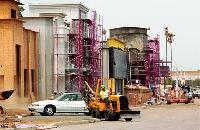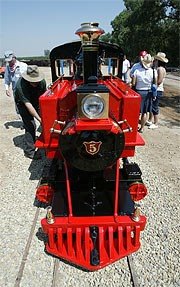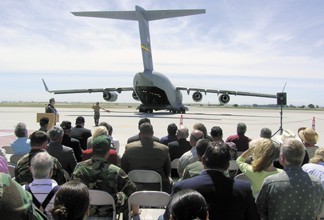Genentech Fights Blindness
By Amanda Janis/Business Writer
TheReporter.Com

Rose Ketchum, of Winters, took part in the clinical trial for Lucentis, a drug developed by Genentech (pictured in the background). Ketchum's eyesight has improved since taking the drug. (Brad Zweerink/The Reporter)
A blindness-preventing drug developed by Genentech is expected to be approved by the Food and Drug Administration today, and one local resident has seen its merits firsthand.
Rose Ketchum lives just south of Winters. Prior to being entered into a clinical trial for the antibody fragment dubbed Lucentis, she was beginning to lose some of her vision.
"I would lie in bed before I got up and close one eye and look at the ceiling, and then close the other eye and look at the ceiling and I would see a great, big, huge black blob," she recalled.
Her ophthalmologist referred her to Bay Area Retina Associates, a group of specialists participating in one of two major clinical trials for Lucentis.
Lucentis is designed to block new blood vessel growth and blood vessel leakage, which cause wet age-related macular degeneration, or AMD. AMD scars the retina, which in turn causes progressive vision loss.
For people aged 60 and older, AMD is the leading cause of blindness, and the condition affects 1.7 million people in the United States, according to The National Eye Institute. That number is expected to grow to nearly 3 million by 2025.
Ketchum met with physicians at Bay Area Retina's Walnut Creek facility approximately two years ago, and was entered into the Lucentis study. The randomized study was organized so that some patients received Lucentis, while others were given mock injections.
"They don't tell you whether you're getting the drug or not," Ketchum explained. She was fairly positive, however, that she was one of the patients receiving Lucentis injections over the course of the two-year study, she said, because she saw "whirly lines" each time she was injected.
"When the trial was over they said I was getting the drug," she said.
Now, Ketchum said, "my vision's pretty good. I don't see the big black spots anymore."
Her experience is in keeping with the results from both clinical trials.
"Both pivotal studies showed 95 percent of patients maintained their vision and up to 40 percent of patients improved their vision," said Dawn Kalmar, Genentech spokeswoman.
Up to 40 percent of patients treated with Lucentis achieved vision of 20/40 or better, she added. That's important, she said, considering that 20/40 is the driving vision requirement in most states.
FDA approval, Kalmar said, is a moment Genentech has been eagerly awaiting.
"It's been over a year now since we had our first positive Lucentis data," she said, noting the company's excitement and eagerness to begin providing the drug to patients.
Ketchum would recommend Lucentis to people suffering from AMD.
"I'd say at least give it a try, although they tell me it's going to be $2,000 a shot," she said.
Genentech has yet to set a price, and will not until all details of the label are negotiated with the FDA, Kalmar said.
"Everybody's speculating," she said, and emphasized the company's commitment to providing drugs to those unable to afford them, or unable to afford co-payments (which may be the case for some Medicare patients who will be treated with Lucentis).
"Last year $200 million was given out in Genentech drugs to patients who couldn't afford it," she said, which equated to helping a total of about 18,000 patients. "We are prepared to do the same thing for patients who can't afford Lucentis."
Amanda Janis can be reached at business@thereporter.com.










